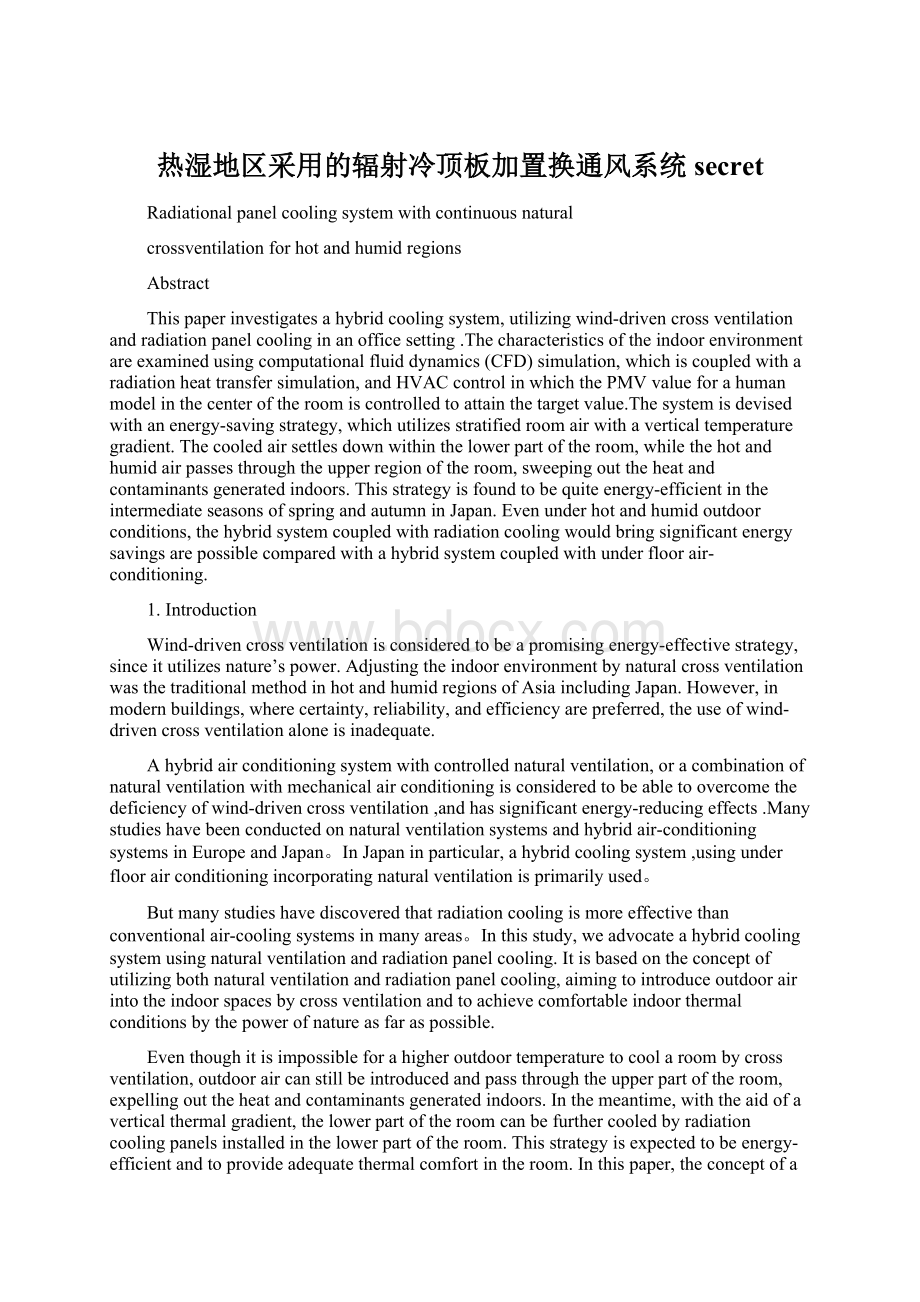热湿地区采用的辐射冷顶板加置换通风系统secretWord文件下载.docx
《热湿地区采用的辐射冷顶板加置换通风系统secretWord文件下载.docx》由会员分享,可在线阅读,更多相关《热湿地区采用的辐射冷顶板加置换通风系统secretWord文件下载.docx(9页珍藏版)》请在冰豆网上搜索。

Abstract
Thispaperinvestigatesahybridcoolingsystem,utilizingwind-drivencrossventilationandradiationpanelcoolinginanofficesetting.Thecharacteristicsoftheindoorenvironmentareexaminedusingcomputationalfluiddynamics(CFD)simulation,whichiscoupledwitharadiationheattransfersimulation,andHVACcontrolinwhichthePMVvalueforahumanmodelinthecenteroftheroomiscontrolledtoattainthetargetvalue.Thesystemisdevisedwithanenergy-savingstrategy,whichutilizesstratifiedroomairwithaverticaltemperaturegradient.Thecooledairsettlesdownwithinthelowerpartoftheroom,whilethehotandhumidairpassesthroughtheupperregionoftheroom,sweepingouttheheatandcontaminantsgeneratedindoors.Thisstrategyisfoundtobequiteenergy-efficientintheintermediateseasonsofspringandautumninJapan.Evenunderhotandhumidoutdoorconditions,thehybridsystemcoupledwithradiationcoolingwouldbringsignificantenergysavingsarepossiblecomparedwithahybridsystemcoupledwithunderfloorair-conditioning.
1.Introduction
Wind-drivencrossventilationisconsideredtobeapromisingenergy-effectivestrategy,sinceitutilizesnature’spower.AdjustingtheindoorenvironmentbynaturalcrossventilationwasthetraditionalmethodinhotandhumidregionsofAsiaincludingJapan.However,inmodernbuildings,wherecertainty,reliability,andefficiencyarepreferred,theuseofwind-drivencrossventilationaloneisinadequate.
Ahybridairconditioningsystemwithcontrollednaturalventilation,oracombinationofnaturalventilationwithmechanicalairconditioningisconsideredtobeabletoovercomethedeficiencyofwind-drivencrossventilation,andhassignificantenergy-reducingeffects.Manystudieshavebeenconductedonnaturalventilationsystemsandhybridair-conditioningsystemsinEuropeandJapan。
InJapaninparticular,ahybridcoolingsystem,usingunderfloorairconditioningincorporatingnaturalventilationisprimarilyused。
Butmanystudieshavediscoveredthatradiationcoolingismoreeffectivethanconventionalair-coolingsystemsinmanyareas。
Inthisstudy,weadvocateahybridcoolingsystemusingnaturalventilationandradiationpanelcooling.Itisbasedontheconceptofutilizingbothnaturalventilationandradiationpanelcooling,aimingtointroduceoutdoorairintotheindoorspacesbycrossventilationandtoachievecomfortableindoorthermalconditionsbythepowerofnatureasfaraspossible.
Eventhoughitisimpossibleforahigheroutdoortemperaturetocoolaroombycrossventilation,outdooraircanstillbeintroducedandpassthroughtheupperpartoftheroom,expellingouttheheatandcontaminantsgeneratedindoors.Inthemeantime,withtheaidofaverticalthermalgradient,thelowerpartoftheroomcanbefurthercooledbyradiationcoolingpanelsinstalledinthelowerpartoftheroom.Thisstrategyisexpectedtobeenergy-efficientandtoprovideadequatethermalcomfortintheroom.Inthispaper,theconceptofahybridcoolingsystemisdescribedandthemeasuredresultsforthecaseswhereoutdoorairtemperatureandrelativehumidityare21℃at60%and30℃at70%areshown.
1.Conceptofradiationalcoolingsystemwithcontinuousnaturalcrossventilation
Fig.1isaconceptualdiagramofthesystemsuggestedinthisstudy.Thiscoolingsystemhasaventilationopeningintheupperpartoftheroomtoprovideventilationtotheindoorsbycrossventilationandtodischargeinternalheatgeneratedintheroom.Dehumidifyingradiationpanels
areinstalledinthelowerpartoftheroomtoregulateindoorhumidityandtoprovidecooling.Evenwhenoutdoortemperaturesbecometoohightocooltheindoors,heatandcontaminantsgeneratedwithintheroommaybedischargedbycrossventilationfromtheupperpartoftheroomwithoutsignificantlydisturbingtheoccupiedzone(ortaskzone),andradiationcoolingpanelsinstalledinthelowerpartoftheroomwouldlocallycooltheoccupiedzoneonly.
Thustheproposedsystemdoesnotignorethepossibilityofadjustingtheindoorenvironmentusingnaturalpower,butmaximizesitsusetomaintaintheindoorenvironmentatacomfortablelevelandtosaveenergy.
3.OutlineofCFDanalysis
Analysisofroommodel
Thehybridcoolingsystemmaybeusedinbothresidentialandofficebuildings.Here,thecaseofanofficebuildingisexamined.TheofficesettingisshowninFig.3.Thedepthoftheroomis10.8m.Thewidthoftheanalyzedareaissetathalfofthe3.6mofficemodule(1.8m),tomakeasymmetricalconfiguration.Hybridcoolingismodeledastheoutdoorairflowsintotheroomfromtheupperopeningofthewindow(0.5m×
1.8m;
Fig.3,left),andisexpelledthroughtheopeningontheotherside(0.5m×
Fig.3,right),whiletheradiationpanelcoolingisstilloperating.Theradiationpanelssetinfrontofthedesksintheroomserveaspartitioningpanels,andcanbeoperatedbelowthedewpointtemperature.Whereasinthecaseofahybridcoolingsystemcoupledwithunderfloorairconditioning,thecooledairissuppliedbydiffusersfromthefloorandreturnsthroughout-letairgrillsintheceiling.People,lighting,personalcomputers,solarheatgains,etctogenerateacoolingload,whichisremovedbynaturalcrossventilation,andradiationcoolingorunderfloorairconditioning.Ahumanmodelisplacedinthecenteroftheroomasthethermalcomfortsensor.
4.Results
4.1.Flowfields
TheflowfieldsforthedifferentcasesareshowninFig.7.InCase1(naturalventilation-radiationpanelcooling),owingtotheconsiderabletemperaturedifferencesbetweentheindoorair(26.6◦C)andoutdoorair(21◦C),thenegativebuoyancyeffectontheinflowingairisapparent.Theinflowingairflowsdownwardstothewindowside,andmixeswiththeindoorairinthelowerpartoftheroom.Thoughnotshownhere,theaircooledbytheradiationpanelsflowsdowntothefloor.
InCase2(naturalventilation-underflowAC),theinflowingairshowsthesametendencyasinCase1.However,thisairmixeswiththeunderfloorACandascendstowardtheupperpartoftheroom.Owingtotheverticaltemperaturedifferenceintheroom,aclockwisecirculatingcurrentisgeneratedontheinnersideoftheroom.InCase3,sincethetemperaturedifferencebetweentheindoorandoutdoorair(30◦C),issmall,thenegativebuoyancyeffectoftheinflowingairisnotapparent.Withthetallercoolingpanel,thermalplumesrisingfromthepersonalcomputerscanclearlybeseen(Fig.7(c)).Thisisbecausetheaveragetemperatureinthetaskzonedrops.ButinCase4,owingtotheverticaltemperaturedifference,theoutdoorairdescendstothefloor.
4.2.Temperaturedistributions
ThetemperaturedistributionsforthefourcasesareshowninFig.8.InCase1,theaverageindoortemperatureis26.6◦C,somewhathigherthanforCase2of24.4◦C.However,theverticaltemperaturedifferenceisslightatabout2◦C.InCase2,duetothesomewhatlowvelocity(0.8m/s)oftheunderfloorAC,thetemperaturenearthefloordropstoalmost20◦C.Asaresult,theverticaltemperaturedifferenceintheroomissteepatabout6◦C,especiallyintheinnerzoneoftheroom.Inbothcases,duetothedescendingcurrentsofincomingair,aratherlow-temperatureregionappearsnearthewindow.InCases3,theroomaveragetemperatureis29.5◦C.Therearevertical
temperaturegradientsintheroom,andahigh-temperatureregionisseenintheupperzoneoftheroombecausetheincomingoutdoorairstaysthere.InCase4,thetemperaturedistributionissimilartothatforCase2,butthetemperaturestratificationbecomescomparativelyclear.ComparedwiththeresultsforCase3,thehigh-temperaturezone(over30◦C)disappearsbecausethehotairiscooledbytheunderfloorairconditioning.
4.3.Relativehumiditydistribution
OnlytherelativehumiditydistributionforCase3isshowninFig.9.InCase1,sincetheradiationpanelsurfacetemperature(19.7◦C)ishigherthanthedewpointtemperature,nocondensationoccurs.Therelativehumidityintheroomairisabout45%overthewholespaceandindicatesarelativelyuniformdistributioncomparedtoCase2.InCase2,theaveragerelativehumidityisabout50%.
Aswiththetemperaturedistribution,asharphumiditystratificationisformed.InCase3,thesurfacetemperatureoftheradiationcoolingpanel(18.3◦C)islowerthanthedewpointtemperature,andcondensationoccursonthesurfaceoftheradiationpanel.Evenafterintroducinghigh-humidityoutdoorair,theaveragerelativehumidityintheroomreachesabout61%becausetheradiationcoolingpaneldehumidifiesthehumidoutdoorair.ComparedwiththeresultsforCase3,theaveragerelativehumidityinCase4(55%)dropsbecauseitiscontrolledbytheunderfloorairconditioning.
4.4.Ageofair(Fig.10)
Theageofthefreshoutdoorairiscalculatedbasedontheresultingflowfields.Thecalculationresultsarenon-dimensionalizedbythenominaltimeconstant.InCases1and2,tnis360s,andinCases3and4itis1200s.InCase1,youngairisobservedinthelowerpartoftheroombecausethefreshoutdoorairmovesintothebottomoftheroom.InCase2,thesametendencyisobservedneartheperimeterzonewithCase1.However,somewhatyoungerairisdistributedoverthewholespace,becausetheoutdoorairmixeswellwiththeindoorairduetotheaircurrentfromtheunderfloorAC.Inbothcases,theairintheinnerpartoftheroombecomesold,owingtothefreshoutdoorairmixingwiththeindoorair.
InCase3,duetotheoutdoorairflowintheu